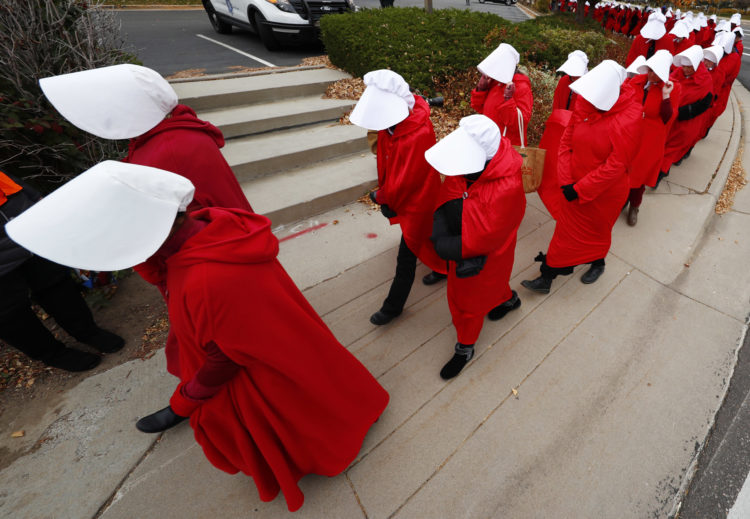
Women wearing "handmaids" costumes represented in the dystopian novels by Margaret Atwood protest an appearance by U.S. Vice President Michael Pence in Colorado in October, 2017. Pence is a staunch opponent of abortion rights.
Atwood wrote “The Testaments” as a long-awaited response to “The Handmaid’s Tale,” a chilling story of totalitarianism following America’s “second Civil War.” (Some might better know “The Handmaid’s Tale,” originally published in 1985, through the Hulu series released in 2017.) “The Testaments” brings the story forward to the underground uprising against the oppressive regime, and then forward again, in the epilogue, to historians studying events from the safe perch of hindsight.
The books are more than worth the read, multiple times, not just for what they say but for how they say it. To call Atwood a master of the craft is to call Michael Jordan a skilled basketball player. Both somehow see things other fine professionals don’t. Both execute moves that leave you, well, breathless.
But let’s just zero in on that sentence, and what makes it great:
“As they say, history does not repeat itself, but it rhymes.”
First, it takes an aphorism that has become something of a cliche: History repeats itself. But it puts a twist on that cliche, challenges it, and asks us to think of it in a new way. We don’t discard the embedded wisdom, but we expand its value.
Second, a small but lovely thing: Subtle alliteration between “repeat” and “rhyme.” Overdone alliteration, like most overdone things, loses its zip. But Atwood doesn’t bludgeon; she hints. It’s a light lisp instead of a harsh hiss. Many readers might skate right over it. No matter, it’s there, adding depth to the line.
Third, that line becomes an echo of the entirety of Atwood’s two books. Throughout both “The Handmaid’s Tale” and “The Testaments,” Atwood leans on history to remind us what happens if it is forgotten. Maybe a darker past is not resurrected in entirety; it does not repeat in a literal sense. But the rhymes are all around. We ignore them at our own risk. (Important note: If you think this kind of thinking and writing apply only to fiction, think again: In narrative nonfiction, we also need to find the heart of what we’re trying to say, make sure our reporting guides us to it or supports it, then build our story around it.)
Finally, and briefly: Timing. Atwood’s new novel, leading to that one sentence, is an unapologetic reflection on the political times we find ourselves in, and have found ourselves in before. The historians, in her epilogue, reference the scourges of slavery 300 years earlier. Atwood, in her acknowledgments, references events in the U.S. and around the world today. History may not repeat itself exactly, but the rhymes are unmistakable.

Canadian Author Margaret Atwood in Toronto in 2019 prior to the release of "The Testaments," a sequel to "The Handmaid's Tale."
